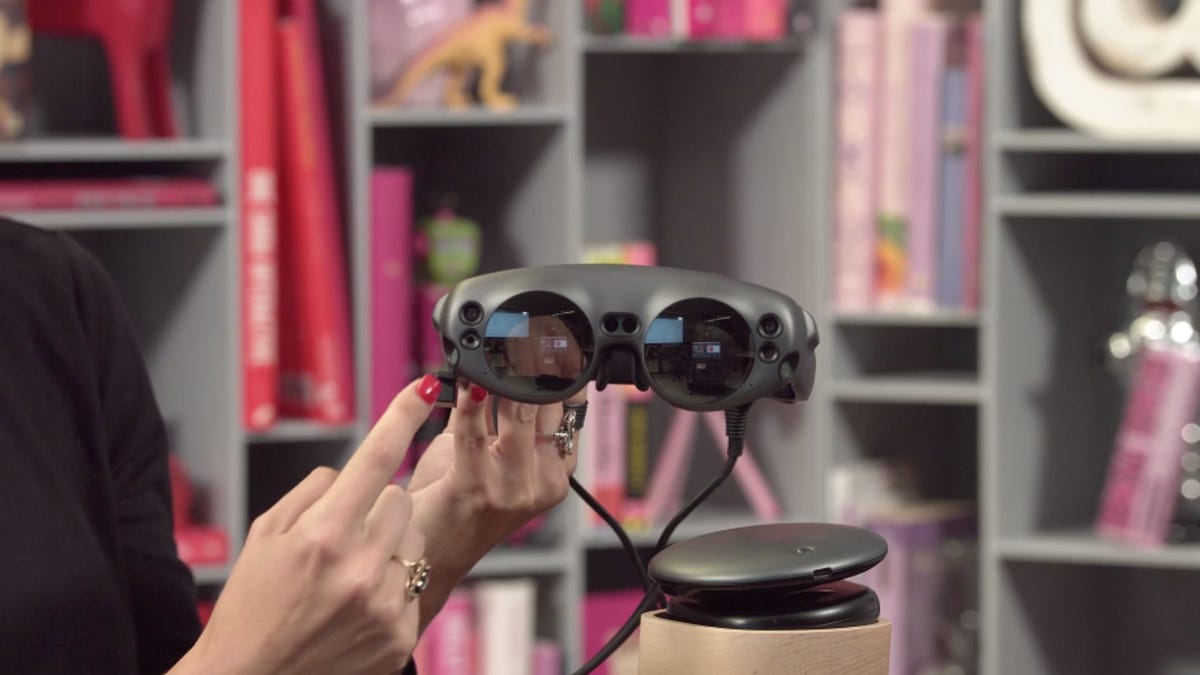Magic Leap's long-awaited headset will ship this summer -- and everything else we learned
CNET watched Magic Leap's latest reveal. Here's your catch-up.

The Magic Leap One head-on.
The Magic Leap One is now available to order for $2295. We got some hands-on time with the Magic Leap One, but if all you want are the facts, here's everything you need to know. We also spent some time at the Magic Leap headquarters in Florida to get the inside story.
On Wednesday, after nearly four years of secrets and speculation, the $2.3 billion Magic Leap revealed that its first mixed-reality headset will hit the market this summer, exclusively on AT&T .
The news came during the company's third livestream on Twitch -- you can watch a replay here -- and it included one of the company's first demos of the technology.
Frankly... I found it a little disappointing. This time the company said it'd have a real demo in tow: "We'll dive into some Magic Leap One specs and share a demo of an upcoming developer sample," the company tweeted ahead of the event -- but what we got was a prerecorded demo that didn't look much better than what we've seen from the likes of Microsoft's HoloLens , and nothing close to the concept videos Magic Leap teased years ago.
That said, even HoloLens still feels like a magical piece of tech, and we suspect much of Magic Leap's magic can't be communicated over the web -- the company has patents on displays that could theoretically make it feel more comfortable and natural to your eyes than any VR or AR headset we've ever tried.
But I digress: Here are all the things we just learned about Magic Leap's headset.
It's finally coming this summer
Magic Leap has been in secretive, NDA-only stealth mode for so long it's hard to believe, but the company just announced right at the beginning of the stream: The first product will ship this summer -- and since we're already partway through summer, it's coming pretty soon eh?
We already know where you'll be able to buy it, by the way: Magic Leap announced that AT&T will get an exclusive on Magic Leap's products earlier on Wednesday.
Do note that there's one hurdle that could potentially delay its release, though: It needs to be certified by the FCC. "This device has not been authorized as required by the rules of the Federal Communications Commission. This device is not, and may not be, offered for sale or lease, or sold or leased, until authorization is obtained," read a message that accompanied Magic Leap's live stream.
Hello, specs!
Magic Leap hasn't dished out many technical details quite yet, but the company did just tell us about the processor inside -- it's an Nvidia Tegra X2 system-on-a-chip with two of Nvidia's higher-power-than-usual-for-phones Denver processor cores inside.
They also say it runs on an undisclosed 64-bit Linux-based operating system with "lots of parts from other systems," and they're recommending that devs use the low-level Vulkan graphics API if they're building their own game engines.
The company kind of dodged a question about power consumption by saying efficiency is up to Magic Leap's software developers, but Magic Leap had previously said battery life would be "several hours."
Our first demo?
We've never seen a live demo of the Magic Leap in action, and that still hasn't changed -- the company showed us a prerecorded demo, sadly. In a real-world living room, a real, flesh-and-blood hand does a "pinching" gesture to drop a digital object into the world, using a spherical mesh-like grid to show your literal sphere of influence.
The headset apparently detects horizontal surfaces like couches and tables, much like other AR experiences you might have recently tried from Google, Apple and Microsoft, so you can place them naturally in the real world -- so they look like they're sitting on top of your furniture, instead of awkwardly floating above them.
What you can't see in the 2D video, according to Magic Leap -- this cute little stone golem throws the rock right at you, which is something you'd be able to see and hear in 3D if you were actually wearing the headset. That's because the Magic Leap hardware shows different images to each of your eyes, and includes built-in spacial audio.
Plus, you can actually dodge the rock by stepping to the side, or block it with your hands. Like some high-end VR headsets, the Magic Leap also has six-degrees-of-freedom sensors inside that can track your movements, and hand-tracking cameras.
Want to watch the demo yourself? Here's a screencapped video from our friends at Road to VR.
Magic Leap's devs say a future demo will show the company driving a tiny car up their real-life walls and across a ceiling.
Some limitations
On the livestream, Magic Leap's developers were upfront that the current tech has some limitations. The headset's lenses can darken, but they don't go totally opaque, meaning that immersive virtual reality games -- as opposed to augmented reality -- aren't likely with the Magic Leap One. You'd still see part of the real world. It also probably means that the experience may not be as immersive in bright light.
Also, the company says there's a limit to how close you can get to virtual objects and cute characters like the golem -- you'll clip right through them if you get too close. So you can't necessarily pick up a tiny digital panda and lift it right up in front of your eyes.
Want more? Here's what we learned about the Magic Leap hardware last month.
Originally published July 10, updated July 11 with livestream and info.
Update, July 12 at 10:30 a.m. PT: Added context comparing Magic Leap to Microsoft's HoloLens.

